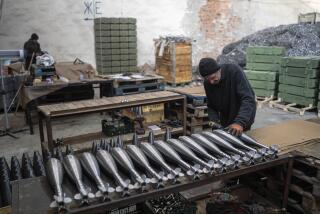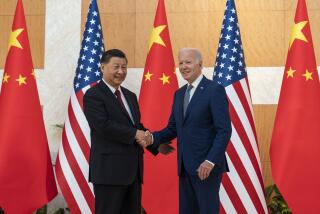Throwing Off Defense Burden, U.S., Soviet Economies Will Rev Up : Retooling: As the arms race winds down, both the U.S. and the Soviet economies have a chance to revitalize their industrial bases.
To some, the onset of peace ushers in a period of diminished expectations for both the United States and the Soviet Union. As the power of the pocketbook outweighs that of the generals, influence is widely seen as shifting from the superpowers to the more commercially oriented societies of Western Europe and East Asia.
Yet despite the dislocations caused by the winding down of the arms imbroglio, the prospect of peace actually offers opportunities to both erstwhile superpowers. After decades of wasteful military spending, a radical reduction in armaments could prove a critical salve for two societies wracked by deepening fears of technological and economic decline.
In comparison with the Soviet Union, America’s conversion problems are relatively minimal. The Soviets spend roughly one-fifth of their gross national product on defense, according to Alexei Kireyev, a senior economic adviser to the International Department of the Central Committee of the Soviet Communist Party--more than three times the 6% spent by the United States.
Yet despite this, U.S. defense expenditures are enormous compared with those of its leading economic competitors--more than twice the proportion of GNP footed by the West Germans and five times the Japanese. Clearly, as Kireyev and countless U.S. economists have pointed out, the lack of a massive defense apparatus presents no hindrance to performing well in the world marketplace.
Yet even with large-scale disarmament now possible, many in both countries still argue for massive military expenditures as a means of achieving technological and economic advantage. Particularly outspoken is former U.S. Defense Secretary Caspar W. Weinberger. Weinberger is warning that any cuts in defense will lead to “the added costs” of unemployment benefits, welfare and food stamps.
Such views, however, are anachronistic in today’s global economy. Certainly, military spending did accelerate tremendous technological advances--from Germany’s development of the jet engine to America’s unleashing of nuclear power--in the crisis environment of World War II and the early Cold War. But as the Cold War military stalemate became institutionalized after the 1950s, the new technologies started to shift from firms whose sole customers were the Pentagon or the Soviet Defense Ministry.
The enormous U.S. defense burden has sapped America’s technological lead in many critical industries. With as much as 30% of its high-tech work force on war-related industries, the United States has been a long-distance runner laden with weights in the technology race with more commercially oriented nations in Europe and Asia. In recent years, even the Defense Department has warned that incipient declines in civilian-based industries--such as sensing devices, semiconductors and computers--threaten national security in today’s technology-sen-sitive defense environment.
Most misleading of all, however, are assumptions about the long-term negative economic effects of defense cutbacks. Certainly, the spate of layoffs at such large defense contractors as Northrop Corp., Hughes Aircraft Co. or Lockheed Corp. will have severe short-term effects on defense-oriented economies such as Southern California’s.
But recent history shows that, rather than slowing down economic development, military cutbacks ultimately spark new growth. Indeed, the real “peace dividend” generated by cuts in defense spending will not come in Washington, but from the release of scarce managerial and technological resources into more productive commercial uses.
This pattern has been clear since 1945--when many predicted postwar military cutbacks would decimate Southern California’s economy. “Peace,” warned Los Angeles Mayor Fletcher Bowron, “threatens industrial dislocations in this area which might throw thousands out of work.”
Despite Bowron’s predictions, Los Angeles’ drive toward massive industrialization barely paused. With the military spigot turned off, entrepreneurs such as the late Charles B. (Tex) Thornton, founder of Litton Industries, tapped wartime-developed technologies to move into the burgeoning fields of commercial aviation, consumer electronics and computer systems.
The same process repeated itself in the mid-1970s, with the cutbacks following the Vietnam War. After a brief recession, Southern California’s adaptable entrepreneurs shifted into fields such as microcomputers and scientific instrumentation. Similar developments took place in Northern California’s Silicon Valley and along Massachusetts’ Route 128.
In the 1990s, Southern California’s economy could reap similar benefits from demilitarization. Certainly a larger portion of the area’s technical work force, the nation’s largest, can now apply their skills to commercial pursuits, creating both new firms and applications for military-derived technologies.
At some companies, such as Kavilco Corp., a small industrial firm in Moorpark, just north of Los Angeles, this transition is already taking place. Until recently, the company sold most of its positioning and measurement devices to makers of military aircraft and missiles--roughly 85% of its sales in 1985. But by 1986, Kavilco president Michael C. Gibson, convinced that defense reductions were inevitable, shifted away from military customers.
“We saw a pressing need to diversify out of being a one-cow company,” said Gibson. “We had a great technology that we figured could be expanded into other areas. The challenge was to take a product made for a few advanced aircraft and turn it into something that could sell in the thousands or millions.”
Today, Kavilco sells more than 70% of its high-tech gear to non-defense customers, such as auto makers and manufacturers of building controls. Sales over the past three years have more than doubled, to $48 million, while employment jumped from 250 to more than 620.
Not all companies, of course, can transfer their technologies with such ease. But engineers and entrepreneurs facing unemployment or cutbacks have a knack for finding new opportunities--sometimes in unrelated areas.
Even abandoned military bases may prove an economic stimulus. Groups such as Business Executives for National Security maintain that, contrary to popular notions, closing bases often stimulates local economic development. They point, for example, to a study of previous base closings by the Pentagon’s Office of Economic Adjustment, revealing a long-term 50% increase in civilian employment in the affected communities.
In much the same way, demilitarization also promises benefits for the Soviet Union, although political and bureaucratic obstacles to successful conversion are likely to be far more severe. Today, military spending absorbs close to 40% of all engineering and scientific resources. This, according to economist Kireyev, has slowed Soviet technological development, even in the military sphere, by spawning highly redundant bureaucratic structures.
Costs for development and production in Soviet military industries, Kireyev estimated, range as much as five times to 10 times above their civilian analogues. Even when turned to commercial tasks, Soviet military industries--which account for 70% of the Soviet Union motorcycles and vacuum cleaners as well as 100% of television sets--are unlikely to cause concern from competitors in Osaka, or even Chicago.
In 1988-89, for example, the Ministry of Aircraft failed to produce 21% of its quota for shoe-making machines, because it found sole-cutting presses, leather-dying units and other shoe-industry machines “too complicated” for its production processes. A Leningrad defense plant gave the same excuse for being unable to produce enough electric teakettles.
“The economic structure of military enterprises has too many layers of management. They are overstaffed and too tied to a command economy,” said Kireyev, who advocated reducing the Soviet military budget to 3% of GNP during the next decade. “They have helped take us out of the world economic system. The only way for us to get back in is to dismantle the military economy.”
Such assumptions are reshaping the economies in both the United States and the Soviet Union. If this leads the superpowers to focus more on providing consumer products and job opportunities for their peoples, it is good news indeed not only for Moscow, but Moorpark.
More to Read
Inside the business of entertainment
The Wide Shot brings you news, analysis and insights on everything from streaming wars to production — and what it all means for the future.
You may occasionally receive promotional content from the Los Angeles Times.










